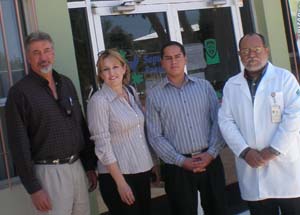- Who We Are
- Clinician Employment
- Publications
- Witness to Witness (W2W)
- Kugel & Zuroweste Health Justice Award
- Your Voice Matters: Photovoice Project
Deportation of Tuberculosis Patients Complicated by a Medication Shortage --- Honduras
From the article:
"The Division of Immigration Health Services (DIHS), within the Bureau of Primary Health Care of the Health Resources and Services Administration, provides health-care and public health services to undocumented persons who are detained by Immigration and Customs Enforcement (ICE) of the U.S. Department of Homeland Security. Detainees in ICE custody are screened for active tuberculosis (TB) disease and, if medically indicated, TB treatment is initiated or continued. Approximately 84% of detainees identified with TB while in ICE custody are deported to their countries of origin before their treatment has been completed." ...
Tuberculosis (TB) is one of the infectious diseases of concern to U.S. public health officials working along with US-Mexico border and with other mobile underserved populations. This concern is based on the fact that TB case rates tend to be higher on the border and among migrating populations. TB is also a challenging disease to treat because of the long treatment period, which is complicated when an individual is migrating during treatment.
In the United States, tuberculosis rates continue to show marked racial and ethnic disparities. Given the parallel disparities in income related to race and ethnicity in the United States, these factors are difficult to separate in epidemiological descriptions. In 2000, U.S.-born persons accounted for 54% of reported TB cases, and 46% of cases were among foreign-born persons. In 1992 only 27% of TB cases in the United States were among foreign-born persons. Mexico was the largest contributing country of origin for U.S. TB cases among foreign-born persons in 2000.
Data on job status of persons with reported TB cases clearly indicates a connection between poverty and the disease. In 2000, 56.8% of TB case records showed that the patient had been unemployed for the past 24 months. Among the employed, health care workers are at higher risk than the general population, comprising 2.8% of all 1997 cases. Migrant farmworkers are also at increased risk. They comprised 1.2% of all U.S. cases in 2000, and are estimated to be six times more likely to develop tuberculosis than the general population of employed adults. Persons with HIV infection are also at increased risk for tuberculosis. Though national statistics are not yet available, Florida reported 38.5% of its 2000 TB cases were in HIV-positive persons, and in Puerto Rico 60% of TB cases were in HIV-positive persons. Most states with available HIV-status data on TB cases reported that 20 to 30% of their total cases were in HIV-positive persons (Georgia, Louisiana, North Carolina, South Carolina, District of Columbia and Tennessee).
However, efforts to control and end TB in the United States cannot focus exclusively on cases within our borders or on surveillance alone. In this age of immigration, emigration, the global market and international travel, no country stands alone in terms of infectious disease. TB, like other communicable diseases, knows no borders. In order to eliminate TB in the United States, the United States must take part in international control efforts.
For more information and resources to diagnosis, manage and treat tuberculosis follow the links on the right of this page. For questions about TB in the migrant population contact Ricardo Garay, MCN's TBNet Program Manager.






